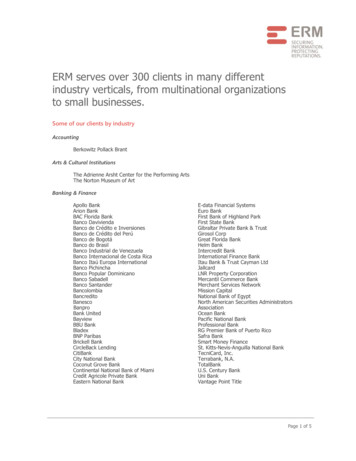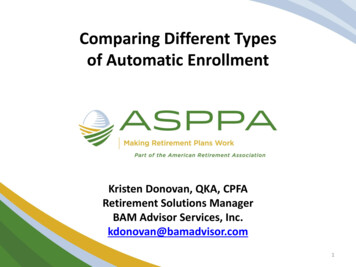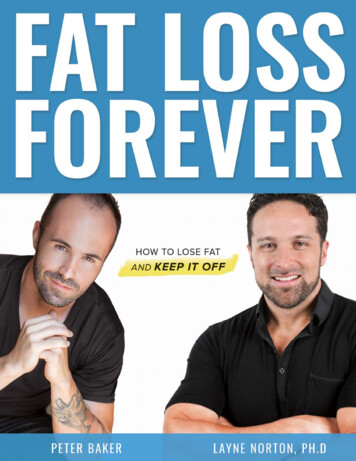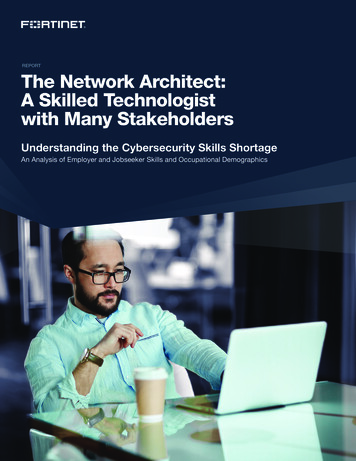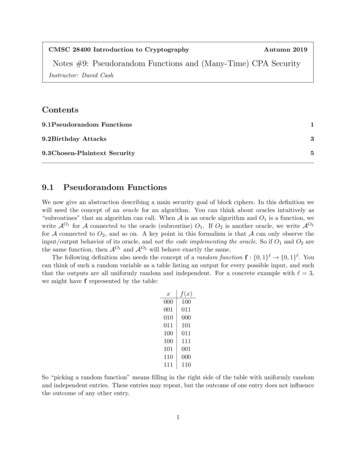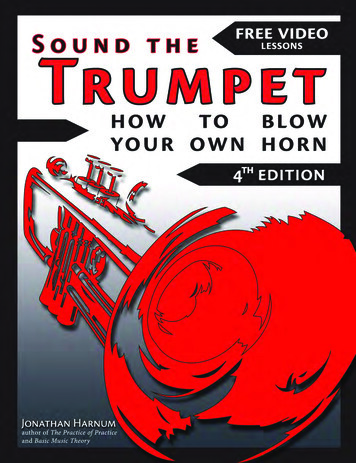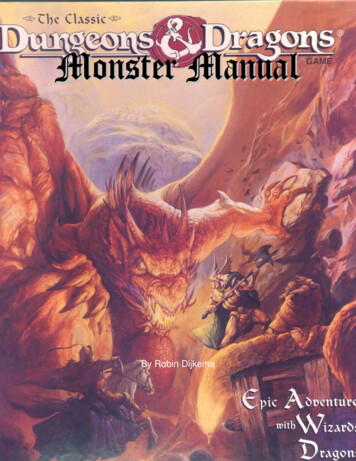
Transcription
Monster ManualBy Robin Dijkema
1
A Word of the Writer/CollectorAt first a word about the D&D books I created/Wrote and collected. The work herein is not completely my own creation. Back in thedays when TSR ruled the D&D world, I got a license to use all D&D materials to make new books. However, when Wizards of theCoast (WOC) took over TSR, and later was taken over by Hasbro, all agreements and contracts made were lost, and apparentlyannulled. The books I created or was busy creating, however, still did exist.rdthBasic D&D (for which these books were created), were replaced by D&D 3 edition, D20, 3.5 and recently even a 4 edition. Allcommercially responsible materials, but the World of MYSTARA of Basic D&D (or now often called Old D&D), was abandoned. As Inow can’t legally sell these books in any way, not even to the new D&D owners (Since they apparently lost interest in Basic D&Dmaterials), I still continued to finish my books for the Basic D&D games. Hereby I made use of any material D&D related I could laymy hands on.Since the book is now solely for personal use (that is for use with my own groups of players) and is not made available on theoutside market by me, and I do not gain any financial benefit from it (actually it did cost me more than I wanted—paper, ink, time(lots of), bindings, bookmaking, etc—much more), you would not normally have access to it. Therefore I made an agreement withmy players only to use this material in a private sense. However, as I don’t have control about the behavior of players and formerplayers this book could end up on the internet.If you do acquire this book, please keep then in mind that, all materials (system, text, tables) are owned by TSR (or their legalowner) and any legal creator / owner of any picture, art piece, drawing, or else. I have added lots of my own materials in the creationif this book, and these rights rest solely upon me (R. Dijkema), these include text, table additions, and some illustrations. I madealso great use of the internet (especially Wikipedia).Because of this and the enormous amount of contributors to this book (actually too much to name individually) the book becamewhat I wanted. An “almost” complete monster manual for the world of MYSTARA, which included any normal animal, Lowlife,Monster, Undead or whatever creature ever did appear in word, text, image, table or otherwise in a MYSTARA book, Module,Gazetteer, Almanac, Boxed Set, Compendium, Magazine, Magazine Article, Internet article, directly linked towards the World ofrdthMYSTARA and basic D&D. The AD&D1 and AD&D2 and even D&D 3 , 3.5, 4 , and d20 material is solely used herein tocomplement the list, or because the “monster’ was listed in another basic D&D article.It took me a lot of work and time collecting information about individual creatures and fixing them together as a whole. By doing this Itried to make the information of any creature as completely as possible. Bruce Heard (Official writer D&D) once called me; “TheFletcher”, due to my skill of mixing game materials, real life information and other together as a whole, and he found that I was verygood in it. I hope to those who use this book they will find also.I tried to make every creature enlisted visually open to the players with the use of art and pictures. Tables were used to make allstatistics consistently compatible with each other. Much of the information is copied from D&D books and other materials speakingabout the creature (the Ecology series from the Dragon Magazines were excellent), other information (like art and pictures Iretrieved from other sources. But also much information is added herein that comes from my own researches, studies, andinvestigations as a biology teacher / student, world traveler, Garden architect, herbalogist, survival trainee, years of gamingexperience (1978-today), and other jobs. As a well traveled and experienced human I have encountered a lot, in word, image oreven true experience. This reality I wanted to include in the D&D material. I hope I did at least partially succeed.I used biological ecological backgrounds to create reasonably acceptable biological ecological environmental explanations ofcreatures, their abilities, or behavior. Of course, many of these creatures don’t exist, but in a fantasy world here they would, and abalance must be available to them. And it is this I did try to explain in this book.Some creatures were very difficult, either I could not retrieve an adequate illustration to clarify the creature, or it was incomplete intext. I tried to fill in these blanks, sometimes by altering other pictures, making my own pictures, renaming pictures, altering text and/ or tables to complement the information given. Where this was not possible I still need this information. In later editions thesepages will be exchanged to a better page.Nothing in this work is meant as an infringement of the rights of any of the artists, contributors, writers, photographers, or other usedherein. Nothing of this work may be sold for profit in any way, without prior agreement with the original artist or owner of the material(Mostly this is TSR—D&D related material, often Wikipedia, sometimes other or my own).NOTE: This material is for fanuse use only, and may not be sold wholly or partially. The illustrations here represented are copyrightof their rightful authors. The reproduction of these pieces of art is not meant to violate copyright laws and it's in no ways a lucrousoperation. It is illegal to distribute and sell them without the prior consent of their author or legal owner.A List of names (as far as I succeeded in collecting) is at the end of the Book (or listed together with the other separate chapters onhttp://pandius.com/mnstrmnl.html ). Where names are incorrect, or missing, inform me, and I try to correct it. Any missing orincorrect name is not a way of threatening the rights of these owners, just that I did never found who truly created the material.Most information (text, Illustrations is taken from D&D, AD&D, AD&D2, D&D3, D&D3.5, D&D4 and Magic the Gathering materials ofTSR owned by WOC. Other information, be it text or illustrations of any kind are primarily taken from Wikipedia, and secondary fromother individual sites.2
3
Creature Catalogue4
How to Read Monster DescriptionsEach entry on the following pages has a description of the monsters, often including notes on their behavior. Every monster isdescribed in the same manner. Different creature types, like animals, birds, dinosaurs, aquatic, canines, slimes, fungi, worms,jellyfish, etc. are give different borders, too make it easier to look them up in this massive document.Monster NameIf the name of a monster is followed by an asterisk (*), then a special or magical weapon is needed to hit that monster.The monster's description tells what sort of weapon is needed. Use these monsters with caution; they are very dangerous to lowlevel characters that may not have the right type of weapon to effectively fight such creatures. An illustration of the creature is givenalso.Monster TypeThis is a general guide as to the type of monster this creature is; different types of monsters have different sets of abilities.Sometimes a monster will belong to more than one of these categories. These monsters are listed in alphabetical order.Normal Animal(including Giant Animals and Prehistoric Animals)A normal animal is any sort ofnonmagical creature that belongs in itsenvironment. If a game "monster" is an animalthat occurs in the real world or is a variant breedof such an animal, it is a "normal animal." Anormal animal may be something as inoffensiveas a field mouse or as dangerous as a tiger.A Giant animal is simply an oversizedversion of a normal animal. It is not magical anddoes not differ in attack forms or behavior from itssmaller counterpart; it is simply more dangerousbecause it is much larger. These creatures areoften magically enhanced in its size but bearrarely magical abilities the originally sized animaldoes not have.A Prehistoric animal is a creature that was once a normal animal in the past but has become extinct on our world; suchcreatures as Sabretooth tigers, dinosaurs, and cave bears are prehistoric animals. In a game world, prehistoric animals may neverhave become extinct or may have become extinct in most places but still exist in isolated areas such as lost valleys. On (or actuallyin) Mystara extinct animals live in the Hollow World reserve the Immortals have created.Lowlife(including Insects, Arachnids, Fungi, Plants, Slimes, and similar creatures)The lowlife creatures are, for the mostpart, nonintelligent (Intelligence 0) and havesimple lifestyles, and act only upon instinct thanintelligence. This could mean that a puddingsensing corporeal heat would attack. Thesecreatures do not defend themselves often, theyflee or attack mostly. Many others are plants,fungi, insects, arachnids, slimes, oozes, or otherinvertebrates such as worms or slugs. Thecategory also includes specimens of huge size.5
ConstructA construct is a monster that is not actually alive, but whichhas been created magically. Thus all constructs are also "enchanted"monsters. A lesser construct can be hit by any weapon. The lesserconstructs include living statues. A greater construct can be hit only bymagical weapons. They are very costly to make. The greaterconstructs include gargoyles and golems. The following general rulesapply to all constructs:1. They can be created only if the proper magical process isused. Rules for their creation are given in the Ultimate Spellbook ormore information is gained in the debriefing of the construct.2. They do not heal normally; magic must be used to curethem of any damage incurred. Some could heal only in specificcircumstances, and then very slowly only), example; the bright sun,flowing water, fire, or old etc.3. They are immune to the effects of poison, and mostlyenvironmental effects (since they are not truly alive) and mental effects(charm, sleep, illusions, etc.).4. They do not reproduce; there are never "baby gargoyles,"for example.UndeadThe undead are creatures that were once alive but now owetheir existence to powerful supernatural or magical forces upon theirspirits or bodies. Most undead can be repelled by clerics or certainobjects, such as holy symbols. Undead are not affected by specialattacks that affect only living creatures (such as poison) or by spellsthat affect the mind (sleep, charm, hold, discord, insanity, Feeblemind,etc.). Undead created by magical spells are "enchanted" monsters, butundead from original (contagious, and emotional stress Undead) arenot. These include Animated Zombies or Skeletons by the spell withthe same name, yet not when they are animated due the evil presenceof an Undead Overlord, limbiotic mishaps etc. also included arerecently created ghouls, wights, wraiths, mummies, and other undeadthat are crated by a magical spell, but not when they are created byinfecting a living body, limbiotic experiences, etc. the DM must decidebeforehand what type of undead he places and why. Undead existthrough the link a spirit or body has with the plane of Limbo. (Furtherinformation is given with each undead separately). Clerics have greateffect over this link and can enhance, create, break or diminish thislink by the use of the powers supplied by their immortals. And althoughNecromancers greatly understand the powers of limbo and are able touse them to create or destroy or use undead, even they know theireffect upon this link is less than that a cleric can exert.6
MonsterA monster is any creature that does not fit into one ofthe other categories. They tend to be legendary or fabulouscreatures, but otherwise may have little in common with eachother. Some resemble members of other groups (humanoids oranimals, for example) but have abilities or powers that set themapart. Some are magical versions of nature normally suppliedbeasts (such as the Unicorn) or come from other planes (like theDisplacer Beast –see photo) or are created somehow (like theBeholder).Dragon(including Dragon like creatures or Dragon-Kin)The dragons are among the fiercest and mostdangerous of monsters. They are huge reptiles with great wings,cruel teeth, sharp claws, and a keen awareness of their ownsuperiority. Most have "breath weapons" (i.e., attacks where theybreath out a damaging effect such as fire), many are of greatintelligence, and some can cast spells. Not all dragons are evil;some are very good, benevolent creatures. There are alsodragon-kin, species related to dragons, such as Chimerae,drakes, dragon turtles, hydras, salamanders, and wyverns.Planar MonsterAll planar monsters have one thing in common: they come from a plane of existence other than the Prime Plane (thedimension that is the player characters' home). Some monsters will have both Prime Plane and other planar versions; these will benoted. Planar monsters that are summoned or gated to the Prime Plane are "enchanted" monsters as well. Most other-planarcreatures do not have "normal” treasures but may have the equivalent in the material of their own planes. For example, valuablegems on the elemental plane of Water may appear as bits of colored ice. When the treasure type given is "Special," the DM maychange the treasures to match the plane.Enchanted Monster"Enchanted" monsters are identified (i.e., the monster can only be harmed by magical weapons or is magically summonedor controlled), and these monsters can be affected by such spells as protection from evil 10' radius. These include HumanoidLycanthropes, Some constructs, but mostly Conjurations of Planar creatures.7
Humanoid(including Human, Demihuman, and Giant Humanoid)A humanoid creature is roughly human in shape (two arms,two legs, biped) but is not human or Demihuman. Lowly monsters suchas goblins fall in this category, as do creatures up to ogre size.Humanoids are subject to the charm person spell. A giant humanoid islike a normal humanoid, only larger and more powerful. These includetrue giants and creatures such as trolls. These creatures are not subjectto the charm person spell. A Demihuman is a member of a nonhumancharacter class: a dwarf, elf, or Halfling. Finally, humans can beencountered nearly anywhere in a game world. They provide manyopportunities for role-playing by both the DM and the players. Inaddition, they can be used to provide goals for the player characters andcan lead to entire adventures. In some cases, the reasons for theencounter may cause some changes in nearby rooms of the dungeon.For example, if the NPC's are acting as bait, the DM may wish to place aharpy in a nearby empty room or to change a given monster to a harpy.Since humans tend to be individuals, an encounter with humans willrequire some work by the DM, but the encounter can be quiteentertaining. The NPC humans do not need to be as detailed as playercharacters. The DM may create each human NPC character in full detailor may use the Type of Human Checklist to find the necessary details.(Note: This same procedure can be used for demihumans). Use theNPC Reasons for Appearing Checklist to generate some encounterideas.NPC Reasons for Appearing Checklist1. Alone, Injured (and Scared):The NPC’s had set out by themselves on an adventure butdiscovered that the dungeon is more dangerous than theyexpected. They wish to join the PC party for safety.2. Bait:The NPC’s are bait, either charmed or controlled by a nearbymonster. The NPC’s will attempt to lead the party to themonster's location without creating suspicion. The monstermay appear while the NPC’s distract the party.3. Escaping:The NPC’s were prisoners of a nearby monster but haveescaped. They have little or no equipment. The monster mightappear soon if aware of their escape.4. Looking for a Friend:The NPC’s are looking for a friend, either rumored or known tohave disappeared in the dungeon. The friend might be aprisoner of a nearby monster.5. Looking for an Item:The NPC’s are looking for a special item either rumored orknown to be in the dungeon.6. Nor What They Seem:The NPC’s are not mere humans. They may be lycanthropes,doppelgangers, gold dragons, etc. The DM should determinethe monster type and run the monsters normally.7. Running Away:The NPC’s are running away from an encounter with a nearbymonster. The monster may be chasing them.8. Sole Survivors:The NPC’s are the only survivors of a recent battle withmonsters. The remains of the rest of their party may be foundin a nearby monster lair.Type of Human(oid) Checklist1. Find Number Appearing2. Determine Class of each (roll 37-8Magic-user, Wicca33-444-59-10Thief 0no class73-7912-133. Determine Alignment of each 8-196Chaotic95-9720-244. Find Reason NPCs' appearance.98-9925-29Select one from the checklist (1d8)0030-365. Select the equipment for the NPCs.Magical items may be added if desired. If so,the items should be used by the NPCs whenever needed.DM; Remember that the NPCs' items may becomeparty treasure if the NPCs are slain,and powerful items should not be given out carelessly.6. Add other details as necessary,either by selecting or rolling randomlyfor AC, Hp, spells, and so forth.8
Climate/Terrain;This line describes the type of terrain the monster frequents (where the creatureis most often found. A monster's home is called its lair. Most monster lairs are inClimates include Typical terrain includesdungeon rooms or outside, hidden in the wilderness. Most monsters will defendArctic,Plaintheir lairs fiercely. In some cases, a range is given; for instance, “cold”Subarctic,Forest,encompasses arctic, subarctic, and colder temperate regions. The monsterTemperate,Forested Hillsneed not be limited to this type of terrain. Terms used to define terrain includeSubtropical,Coastthe following.Most listed in the tables are self-explanatory.Tropical.Rough/Broken LandsCavern:This includes natural caves, deep fissures, grottoes, naturalAerialHill,tunnel complexes, and other underground settings.SpacialFoothillsCold/Arctic:These are areas of snow-capped mountains, ice-sheets,Inter-spacialMountain,snow-covered plains, and tundra.WandererSwamp/Moor/BogDesert:This terrain includes arid barrens, hot rocky plains, sandseas, and similar areas.DesertLost World:This is a special area cut off from the outside world, wherecreatures from a bygone age live on unchanged, including prehistoric areas.Mountain:These are rocky areas, including cliffs, gorges, mesas, peaks, volcanoes, and so on; it also extends to includehills, rocky barrens, and other very rough and broken terrain.Ocean:Oceans include salt water seas and surface and underwater encounters. Coastal encounters are speciallynoted.Plains;This is clear or rolling ground, without high vegetation (also called Open), including grasslands, Heide,savannahs, steppes, scrubland, Tundra, veldt, and moorlands.River/Lake:This includes freshwater encounter areas, with both surface and underwater encounter possibilities.Ruins:These are ruined or abandoned buildings, artificial underground complexes (dungeons), tombs, crypts,graveyards, and similar desolate places.Settled:These areas contain villages, towns, cities, and other (generally human) communities from which mostdangerous creatures have been driven. The opposite of a settled area is wilderness, where most adventurestake place.Swamp:This terrain includes swamps, marshes, bogs, and similar low, wet ground.Woods:This terrain is woodland, forests, jungles, and similar terrain, including wooded hills.Climates are regulated by average temperature and moisture differences (i.e. Rain and evaporation). So these regions know dryversions and wet versions as in the table.The region on the Poles and top's of the highest mountains (called Alvar). Here grow no plants. And the overallArctic / Polar;temperature is very low. Seasonal differences are almost none.Sub-arctic;This is the secondary climatic region, here grow only the lowest plants, and funghi. The overall temperature iscold and seasonal differences are small. This region is also found on mountains as the alpine region.Temperate;This next region is border to the subarctic by the Tree border. From here bushes and trees grow more abundantthe further towards the equator and lower down the mountains. The overall temperature is strongly regulated byseasonal trends ranging from cold to warm. The region is called in mountainous areas Montane.Subtropical;This Region is rich in plant and animal life and very diverse in territory.Tropical;This region on the equator is very prolific in plant and animal diversity.9
Frequency;Frequency is the likelihood of encountering a creature in any given area. Dm’s can adjust these chances for special locations. It ispossible for a character to encounter an enemy that is way out of their league or is just so low it is mere a distraction. Use these asthe creature behaves by the given rules. A beholder encountering a group of first level heroes will defeat them in a jiffy, give thecharacters a way to prevent being seen or a way of escape, and they will always remember that particular encounter as one to beshit y’r pants full. That is a hell of a role-playing situation that if correctly played will be truly awesome, yet if wrongly played willdestroy the whole sprit of role-playing in to a hack-and-slash experience or a one-time killing spree. Beware of this and clearly giveplayers a chance, else they will soon lose interest in the game.The other way around does count too. A high level experienced character will often encounter animals or low-level humans, whichthey could slay in a mere instant. Keep the characters to their alignments (only evil characters would kill all they encounter, and evilcharacters are not to be used by players but by the DM). One-way to keep track of this is giving the players no experiencewhatsoever for slaying these, not even for keeping their treasure. And if they continue to do this change their alignment one step(explain why) and the reactions of other characters thereupon. Or strictly forbid it and explain why; Evil characters are not to be usedby Players!! A DM can create balanced heroes with all items and magic needed to vanquish these players if need be. Alsoremember, evil players will never be friends, and the other players will either want to vanquish it or take its place. This is a way ofno-go, and thus would destroy the whole spirit of role-playing, and is the sole reason that evil characters are solely for the DM!!Very rare 4% chance Very rare creatures should only show up in extraordinary places or Circumstances and should usuallyappear in carefully planned encounters or in Seldom-visited settings.Rare 11% chance Rare creatures should appear seldom, but many know of them.Uncommon 20% chance Uncommon creatures appear less frequently than common monstersCommon 65% chance Common creatures will appear frequently in a campaign;Organization;Organization describes the general social structure a creature adopts. There exist othr names for organization forms given here.These are used on thiscreatureonly.(seeindividual creature)Solitary; Singleindividuals butincludes smallfamily groups.Herd;Large groupof intermixingcreaturesliving togetherfor safety ofnumber.Flock;Flying goal.Group; Any numberof creaturesliving togetherFamily; Groupofcreaturesrelated livingtogether.Nest;Parents andyoung livingtogether during growth to adulthood.Activity Cycle;Activity cycle is the time of day when the monster is most active. Light is the key for “nocturnal“ creatures; in subterranean settings,they could be encountered anytime. The activity cycle listed is a general guideline and exceptions are fairly common.Night/Nocturnal:The creature is normally active at night, sleeping during the day. However, dungeons are often dark as night,and a nocturnal creature may be awake during "daylight hours" if found within a dark dungeon.Day:The creature is active during daylight, and will often remain in its lair during night, darkness or twilight.Twilight;The creature is active twice a day, in the 2 to 4 hours of twilight around sunrise and nightfall.Other;Some rare creatures have their own activity periods.10
Basic Era;This gives the basic era in which the creature lived. The existence of live is divided in great eras of time, ending often with ageological disaster, like meteor impact, solar flares or similar. This also led to great extinctions worldwide, but gave also othercreatures a chance to evolve. The table goes from left to right. Where this is not given, the creature exists in the present times andcould thus also exist in more primitive forms in the neogenic era. Some creatures, like dragons have evolved early in time and stillexist today. These living fossils are rare in the real world, but much more common on Mystara. The evolutionary disasters were notas great on Mystara as on our own world.Ma means million years ago.Once the world was shaped, life iscreated upon its (outer) surfaceover millions of millennia. Somespecies and races evolve naturally;others are created by ancient,elementalImmortalsandbyunknown forces. Eventually a timecomes when Mystara is occupied bygreat beasts of all sizes andvarieties—especially huge reptilesand dinosaurs.As some of these races learn tomanipulate magic, they too begincreating entirely new species. Andas they probe ever deeper into theworkings of magic, some of themlearn of the path they could take toImmortality. A few of the ones wholearned of the path actually set outon it. A (very) few of the ones whoset out on the path actually achieveImmortality.Ordovician SeaSeveral Disasters passed by.Some accidentally and natural,other through war, stupidity orignorance. All these changedthe face of the planet and rsaccidentelyorpurposedly landed on Mystara.Somecreaturesbecameextinct, others evolved or werecreated. This means that somespecies may not anymore existor exist yet in the time periodthe characters wander in.Basically the eras are equal tothose of Earth, yet morecreatures survived from bygoneeras and still can be found onisolated locations or in theHollow World, which is madeinto a reserve for creatures ofbygone eras. Others may havebecomeextinctastheimmortals did not notice theirdemise, were not interested orchoose not to.Devonian Era11
Were needed this is mentioned inthe text description or the table.Were this is not done. Take theseaverages;Cambrian; Aquatic life only,Ordovician; Aquatic Life Only,Silurian; Mainly Aquatic otherCoastline (especially Plants andcreatures,Permian;Globalcreatures(mainly coastlines),Carboniferous; Early Dinosaurs,Triassic; Dinosaurs, Early Birdsand Mammals,Jurassic; Dinosaurs, Small Birdsand mammals,Cretaceous; Great Dinosaur age, small birds andmammals,Carboniferous EraGreat Meteoric DisasterGreat Meteoric Disaster; major global extinction,Cretaceous eraPalaeocene; Giant Mammals,Miocene (also called Quaternary); Evolved Mammals, (This is the era the characters live in. it spreads from 2.5 million years ago tothe characters current time). In this document are used timelines that further specify the era in it self or part thereoff as important tothe creature.12
Diet;Diet explains what the creature (this could be Plant, Animal, Extra-planar,Construct, Undead or different) usually eats. If a monster does not fit any ofthese categories, the substances it does devour are described in the maintext. A Carnivore prefers to eat meat and does not usually eat plants, but aseverybody knows, cats (example) do eat grass, or even fruits to complementtheir vitamins, or attempt to cure ailments. Elephants like to eat large amountsof mineral chalk and salt and would go for millennia long ancient paths to getto it, while camels, will even eat meat in periods of drought. In other words thecreature can sometimes consume other food, it normally would prefer. Othercreatures are a mixture of dietary types. Plants can be photosynthetic andparasitic; many creatures live in symbiosis with another while still having itsown diet, and so on.DietMeatInsect, SpidersDead Meat, CarrionEssenceBloodPlantsFruitsFungusNearly anything EdibleSediments/LightLiving on CreatureLiving with CreatureMagic rePhotosynthesisParasiteSymbiosisErnergis-A Word about SensesMost creatures have senseslike Sight, Hearing, touch, Special AbilitiesSensestaste, and Scent, and theyHighMediumLow SensesNone(as Human)have these senses in much Detect Predator/Nemesis83%66%0%0%greaterstrengththan Detect Invisible & Ethereal Beings:Int 8Int 4Int 2notTracking:Wis 8Wis 6Wis 4Only with skillhumans.SuccessInt. at 4Int. at 2notWhen nothing is mentioned, Odor Scenting; Race:Int.Int –2Int –4notit is assumed these creatures Odor Scenting; Individual;Detect Noise:35% 2%/Lvl 30% 1%/Lvl 25%, no bonus7% /-Dex adjusthave low senses.Some other creatures have Weakness, Penalty vs. Saves odoradditionalsenseslike or sound-based attacks-2-1No weaknessnoneInfravision (many night or (a stinking cloud, a banshee’s wail, etc).darklivingcreatures),Darkvision (dark living creatures), Tremorsense (like worms and burrowing rodents), electrical field detection (like Sharks),echolocation (like Bats and Dolphins), ESP thought reception (planar creatures), or even area detection fields (like the Krakenor other giant squid. These are given in the descriptions of the creatures having these senses.These abilities are often limited to a specific range. Beyond this range the creature does not sense anything, so
Basic D&D (for which these books were created), were replaced by D&D 3 rd edition, D20, 3.5 and recently even a 4 th edition. All commercially responsible materials, but the World of MYSTARA of Basic D&D (or now o
